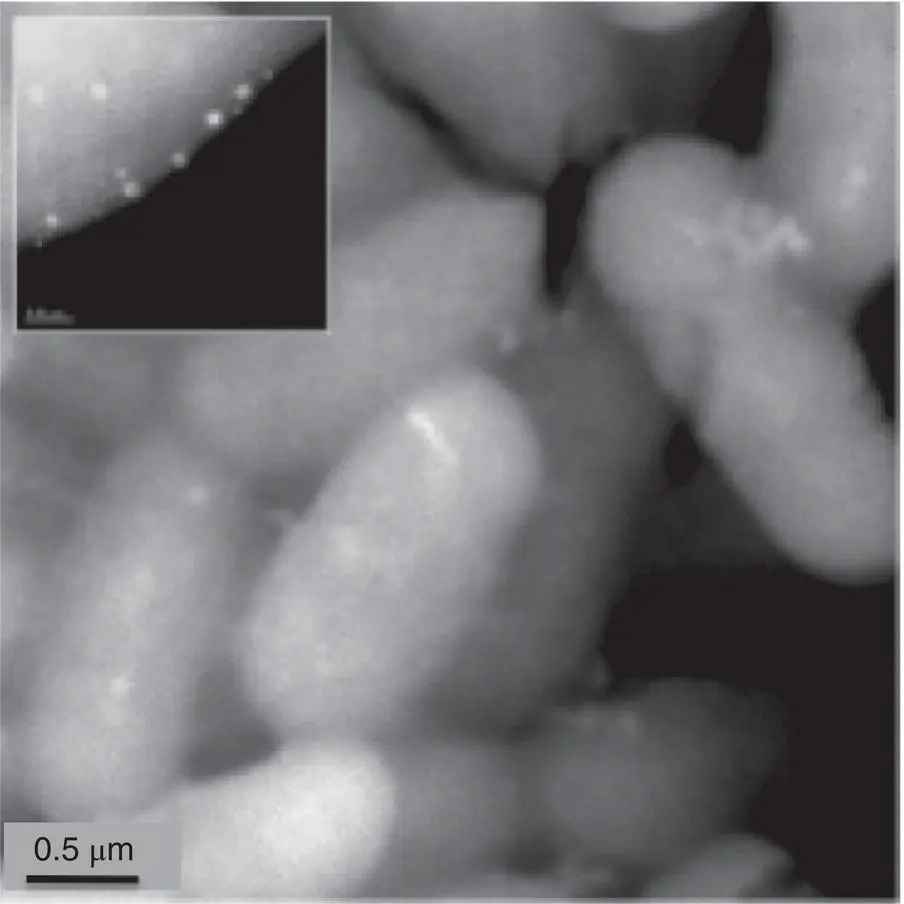Silver has made a comeback in the form of nanoparticles, however, because of its greatly increased effectiveness, partly because of the high surface/volume fraction so that a large proportion of silver atoms are in direct contact with their environment. In addition, entire nanoparticles are sufficiently small to pass through outer cell membranes and enter cells' inner mechanisms. A study using nanoparticles with a wide size range [19] showed that only silver nanoparticles with sizes in the range 1–10 nm were able to enter cells and disrupt them. Some particles attached to the cell membrane and disturbed its functions, such as respiration. Others penetrated the outer membrane and caused further damage including damage to the cell DNA. Figure 1.16shows an electron microscope image of some Pseudomonas aeruginosa 5 bacteria after they had been exposed to silver nanoparticles, and the high magnification inset reveals some nanoparticles attached to the cell membranes. This strain can be particularly problematic to cystic fibrosis sufferers as it readily colonizes the favorable environment found in their lungs. It protects itself by producing a thick mucus layer, which makes it difficult to treat with antibiotics once it is established. Silver nanoparticles suspended in an aerosol could prove to be an effective treatment. Other metal nanoparticles such as copper, magnesium, titanium, gold, and zinc have also been found to be effective antibacterial agents and one attractive aspect of using inorganic materials such as these is that it is harder for bacterial cells to evolve ways to become resistant.
There has been less research on the antiviral effectiveness of nanoparticles but it has become a more active topic of research following the Covid‐19 pandemic of 2020. Viruses are much smaller than bacteria and are inhabitants of the Nanoworld as illustrated in the introduction (see Figure I.1). The original report of the interaction of silver nanoparticles with viruses came in 2005 from the same team that carried out the work described above on bacteria [20]. They exposed HIV‐1, the virus responsible for AIDS, to silver nanoparticles and discovered that, again, the important size range is 1–10 nm. As shown in Figure 1.17c, nanoparticles of this size attach themselves in an ordered array on the surface of the virus. The HIV‐1 virus is covered in a regular arrangement of glycoprotein “knobs” ( Figure 1.17a), and the average distance between the silver nanoparticles in the image suggests that they attach themselves to these knobs. The team went on to demonstrate that the nanoparticles prevent the virus from binding to host cells. Viruses on their own are not able to replicate, so they need to enter the cells of the host and ambush the biological machinery of the cell to make copies of themselves. They anchor onto cells via the glycoproteins to gain entry via the cell membrane, so attaching nanoparticles onto the proteins as in Figure 1.17c prevents the virus particles from entering the host cells and they are left floating around homeless till they get picked up by the immune system.

Figure 1.16 Silver nanoparticles attacking bacteria. Electron microscope image of P. aeruginosa 5bacteria after exposure to silver nanoparticles. The particles with size ranges 1–10 nm are active in disrupting the cell function. The inset shows a high‐resolution image of some particles attached to the cell's outer membrane.
Source: Reproduced with the permission of the Institute of Physics from J. R. Morones et al. [19].
Since the original work, silver nanoparticles have demonstrated strong antiviral potential against several other viruses, including herpes simplex, hepatitis A virus, hepatitis B virus, huma papillomavirus, and respiratory syncytial virus [21, 22]. All of these viruses have a similar general morphology to that shown Figure 1.17a with a roughly spherical shape and a diameter in the range 40–200 nm, that is straddling the boundary of the nanoworld. They all have an array of glycoproteins on the surface and it is thought that the silver nanoparticles act against them in the same way as in the case of HIV, that is, binding to the glycoproteins and locking the virus out of the host cells. As in the case of bacteria, it is harder for viruses to become resistant to silver nanoparticles as compared to conventional antiviral agents
Here, we have only encountered very brief sketches of a couple of examples of applications of nanoparticles in healthcare. This is a huge and burgeoning field and a more comprehensive discussion is postponed until Chapter 8. As a final example in this chapter, it is worth noting that there is increasing use of nanoparticles in cosmetics such as face creams. In order to replenish certain compounds in the skin, whose reduced concentration is partly responsible for the effects of aging, it is necessary to enable these compounds to penetrate the outermost layers. This can either mean producing the compounds themselves as nanoparticles or binding them onto “carrier” particles that transport them to the deeper layers. Some sunscreen manufacturers now use titanium dioxide nanoparticles in new products as the carriers.
The key aims of this chapter have been to give an impression of the nanometer size scale and to introduce the idea that sufficiently small pieces of matter behave differently from the bulk material. In addition, the novel behavior of nanoparticles depends on their size and several examples have been introduced where the unusual behavior can be put to good use in technology. All the topics discussed fall into the category of Incremental Nanotechnology, and it is evident that this category is already being used or will shortly be used in industrial sectors as diverse as magnetic recording to medicine. All the types of nanoparticles presented here are artificially produced but in the following chapter, naturally occurring nanoparticles and their effect on the environment and our health will be discussed.

Figure 1.17 Silver nanoparticles attached to HIV‐1.(a) Computer‐generated image of HIV, showing glycoprotein “knobs.”
Source: Reproduced with permission from www.virology.net/Big_Virology/BVretro.html.
(b) Electron microscope image, with inset superimposing position of glycoprotein knobs. (c) Electron microscope image of virus after attachment of silver nanoparticles.
Source : Reproduced with the permission of BioMed Central from J. L. Elechiguerra et al. [20].
1 1 Silver, whose density is 10 490 kg/m3, is used to form spheres of different diameters. Calculate the surface area in m2 of 1 g of Ag spheres of diameter:1 mm10 μm10 nm
2 2 Calculate the proportion of atoms on the surface atomic layer of Ag spheres with the diameters below given that the thickness of the surface atomic shell is 0.289 nm, stating any assumptions made.1 μm10 nm5 nm
3 3 In a magnetic material, the energy of the exchange interaction between neighboring atoms is about 1 eV/atom whereas the magnetic dipolar interaction between neighboring assemblies of atoms averages at 10−5 eV/atom. Use the data to estimate the maximum size of a spherical single‐domain particle. (Hint: assume the exchange interaction only operates between atomic neighbors, whereas in a small particle the dipolar interaction affects all atoms equally. In addition, for an estimate, assume the atoms are cubes with a width of 0.2 nm). 6
Читать дальше














